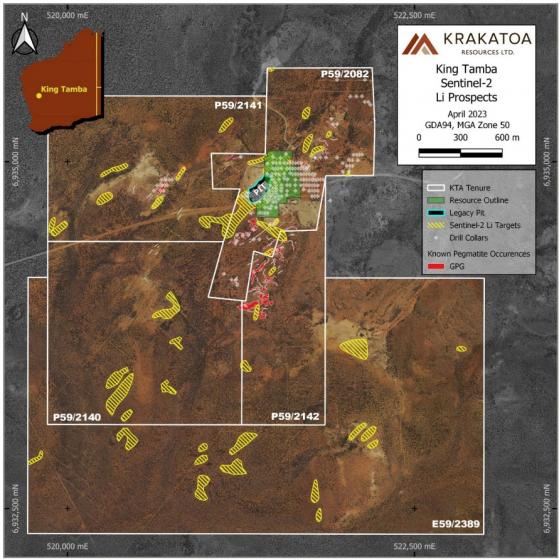Krakatoa Resources Ltd (ASX:KTA) shares rose as much as 7.4% higher intra-day to 29 cents after identifying the potential for lithium-caesium-tantalum (LCT) pegmatite through a remote sensing study at its King Tamba Project in Western Australia.
Prior to Krakatoa’s acquisition of King Tamba, historical exploration focused on tantalum with minimal exploration completed outside the main mining area.
Having undertaken the remote sensing study, Krakatoa has identified areas highly prospective for near-surface pegmatites providing a strong platform for future geochemical and mapping exploration.
Last month, Krakatoa delivered a major milestone at King Tamba in the form of a maiden resource of 5 million tonnes at 0.14% rubidium (Rb2O) and 0.05% lithium (Li2O).
Read: Krakatoa Resources delivers “impressive” maiden resource at King Tamba; rubidium the highlight
Krakatoa CEO Mark Major said: “Following the delivery of the maiden MRE at King Tamba, we are focused on continuing our exploration and development push to expand our multi-commodity project in size and scale.
“King Tamba was a historical tin and tantalum mine and our reconnaissance work within this area has identified compelling targets for our next exploration campaign at King Tamba.
“Importantly, we also completed a wildcat hole 800m south of the MRE area and intersected solid grades of rubidium and lithium and we will also look to explore this area further.”
Sentinel-2 remote sensing study
Krakatoa commissioned DiRT Exploration Services to perform a first pass study of Sentinel-2 remote sensing data over King Tamba with respect to lithium prospectivity indicators.
The study considers spectral mineralogy and addition of gas emissions of H2, He, and CH4 with consideration of their possible geological sources.
A combined targeting index is then determined by compositing the spectral responses of known lithium occurrences in the region and comparing to the responses in the King Tamba area.
The study has identified multiple targets with potential to host LCT mineralisation.
Sentinel-2 Lithium pegmatite targets showing current mineral resource area and historical pit.
The highest ranked of these targets are zones which correlate with known mapped pegmatite outcrops that were identified during historic tantalum prospecting.
Many other target zones lie over areas which have not previously been subject to mapping, sampling, or drilling.
Sentinel-2 and other comparable remote sensing systems have been used to great effect for target generation in mineral exploration, with many discoveries at least partly credited to their input.
Recent examples include Palabora mine (South Africa) and Quellaveco mine (Peru) where Sentinal-2 data helped identify a new copper deposits.
The Sentinel 2 spectral targets were developed at a desktop level and as such will be further refined with field reconnaissance mapping where outcrop is present.
Krakatoa has already confirmed a pegmatite-hosted rubidium resource and combined with the historical mining of pegmatite for tantalum and tin provides a strong platform for future exploration success.
Field testing of these targets will be carried out as a priority in the upcoming field season which is expected to start this month.
Read more on Proactive Investors AU
